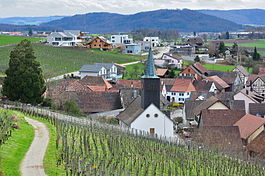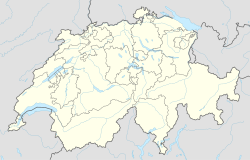|
Dörflingen
Dörflingen is a village and a municipality in the canton of Schaffhausen in Switzerland. It borders a short strip of the north shore of the Rhine. HistoryDörflingen is first mentioned in 1264 as Dorfelingen.[3] Geography  Dörflingen has an area, as of 2006[update], of 5.8 km2 (2.2 sq mi). Of this area, 64.3% is used for agricultural purposes, while 26.9% is forested. Of the rest of the land, 7.5% is settled (buildings or roads) and the remainder (1.4%) is non-productive (rivers or lakes).[4] Dörflingen is located in the Reiat district, about 6 km (3.7 mi) east of Schaffhausen and has two separate international borders with Germany, one of which being with the German exclave of Büsingen am Hochrhein. EconomyDörflingen has an unemployment rate of 1.02%. As of 2005[update], there were 60 people employed in the primary economic sector and about 26 businesses involved in this sector. 68 people are employed in the secondary sector and there are 9 businesses in this sector. 56 people are employed in the tertiary sector, with 14 businesses in this sector.[4] As of 2008[update] the mid year average unemployment rate was 1.3%. There were 22 non-agrarian businesses in the municipality and 64.2% of the (non-agrarian) population was involved in the secondary sector of the economy while 35.8% were involved in the third. At the same time, 72.4% of the working population was employed full-time, and 27.6% was employed part-time. There were 123 residents of the municipality who were employed in some capacity, of which females made up 26% of the workforce. As of 2000[update] there were 81 residents who worked in the municipality, while 319 residents worked outside Dörflingen and 41 people commuted into the municipality for work.[5] As of 2008[update], there is 1 restaurant and the hospitality industry in Dörflingen employs 7 people.[5] DemographicsDörflingen has a population (as of 31 December 2020) of 1,010.[6] In 2008 a total of 11.6% of the population were foreign nationals. Of the foreign population, (as of 2008[update]), 53.2% are from Germany, 13.8% are from Italy, 1.1% are from Croatia, 1.1% are from Serbia, and 30.9% are from another country.[5] Over the last 10 years the population has grown at a rate of 3.9%. Most of the population (as of 2000[update]) speaks German (96.6%), with Italian being second most common (1.4%) and Serbo-Croatian being third (0.8%).[4] The age distribution of the population (as of 2008[update]) is children and teenagers (0–19 years old) make up 22.7% of the population, while adults (20–64 years old) make up 62.9% and seniors (over 64 years old) make up 14.4%.[5] In the 2007 federal election the most popular party was the SVP which received 42.9% of the vote. The next two most popular parties were the SP (28.7%), and the FDP (28.3%) .[4] The entire Swiss population is generally well educated. In Dörflingen about 86.2% of the population (between age 25–64) have completed either non-mandatory upper secondary education or additional higher education (either university or a Fachhochschule).[4] In Dörflingen, as of 2007[update], 1.4% of the population attend kindergarten or another pre-school, 7.11% attend a Primary School, 4.82% attend a lower level Secondary School, and 3.17% attend a higher level Secondary School.[5]  As of 2000[update], 18.9% of the population belonged to the Roman Catholic Church and 61.7% belonged to the Swiss Reformed Church.[5] The historical population is given in the following table:[3]
SightsThe village of Dörflingen is designated as part of the Inventory of Swiss Heritage Sites.[7] Images References
External linksWikimedia Commons has media related to Dörflingen.
Information related to Dörflingen |
||||||||||||||||||||||||||||||||||||||||||||||||||||||||||||||||






